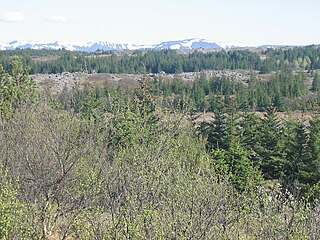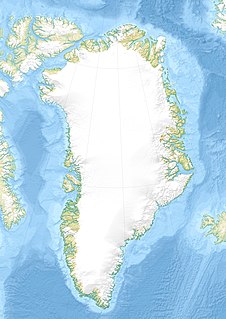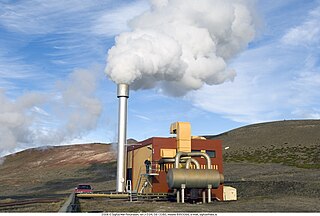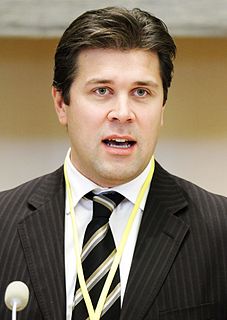
Iceland is an island country at the confluence of the North Atlantic and Arctic Oceans, east of Greenland and immediately south of the Arctic Circle, atop the constructive boundary of the northern Mid-Atlantic Ridge about 860 km (530 mi) from Scotland and 4,200 km (2,600 mi) from New York City. One of the world's most sparsely populated countries, Iceland's boundaries are almost the same as the main island – the world's 18th largest in area and possessing almost all of the country's area and population. It is the westernmost European country with more land covered by glaciers than in all of continental Europe.

Hydroelectricity is electricity produced from hydropower. In 2015, hydropower generated 16.6% of the world's total electricity and 70% of all renewable electricity, and was expected to increase about 3.1% each year for the next 25 years.

Kárahnjúkar Hydropower Plant, officially called Fljótsdalur Power Station is a hydroelectric power plant in Fljótsdalshérað municipality in eastern Iceland, designed to produce 4,600 gigawatt-hours (17,000 TJ) annually for Alcoa's Fjarðaál aluminum smelter 75 kilometres (47 mi) to the east in Reyðarfjörður. With the installed capacity of 690 megawatts (930,000 hp), the plant is the largest power plant in Iceland. The project, named after the nearby Kárahnjúkar mountains, involves damming the rivers Jökulsá á Dal and Jökulsá í Fljótsdal with five dams, creating three reservoirs. Water from the reservoirs is diverted through 73 kilometres (45 mi) of underground water tunnels and down a 420-metre (1,380 ft) vertical penstock towards a single underground power station. The smelter became fully operational in 2008 and the hydropower project was completed in 2009.

Bad Taste is one of Iceland’s most important record labels; located in Reykjavík and known worldwide for being home to The Sugarcubes, it also publishes poetry books, short films, greeting cards and Icelandic gifts. Bad Taste should not be confused with Bad Taste Records, a distinct record label based in Sweden.

Hilmar Örn Hilmarsson, also known as HÖH, is a musician, an art director, and allsherjargoði of Ásatrúarfélagið.
Statkraft AS is a hydropower company, fully owned by the Norwegian state. The Statkraft Group is a generator of renewable energy, as well as Norway’s largest and the Nordic region’s third largest energy producer. Statkraft develops and generates hydropower, wind power, gas power and district heating, and is also a player in the international energy markets. The company has some 4200 employees and their headquarters is located in Oslo, Norway.

Heiðmörk was proclaimed a municipal conservation area of Reykjavík in 1950. It is located southeast of Elliðavatn, Iceland, and is about 6 miles (9.7 km) from the city of Reykjavík. Its name is derived from its namesake in Norway, Hedmark, an area with deep forests.

About 85% of the total primary energy supply in Iceland is derived from domestically produced renewable energy sources. This is the highest share of renewable energy in any national total energy budget.

Þjórsárdalur is a valley in Árnessýsla county in Iceland that lies between mount Búrfell alongside the river Þjórsá to the east and mount Skriðufell to the west. The valley is quite flattened over and pumicey after repeated eruption of the nearby volcano Hekla as well as other volcanoes in the vicinity like the Vatnaöldur volcanic system which produced Iceland's biggest known lavafield Þjórsá Lava (Þjórsárhraun) in prehistoric times or the Grímsnes volcanic system with the crater Kerið. Landmarks in Þjórsárdal include Þjóðveldisbærinn Stöng, Gjáin, Háifoss, and Vegghamrar.

The Hálslón Reservoir is a storage reservoir in Eastern Iceland on the Jökulsá á Dal River. The reservoir stores water for use in hydroelectricity production with the Kárahnjúkar Hydropower Plant. The reservoir was formed by three different concrete-faced, rock-filled embankment dams: the Kárahnjúkastífla Dam, the Desjarárstífla Dam and the Sauðárdalsstífla Dam.

Qorlortorsuaq Dam is a hydroelectric dam near Qorlortorsuaq in the Nanortalik district of the Kujalleq municipality in southern Greenland. It has a capacity of 7.2 MW and it generates power for the neighbouring towns of Qaqortoq and Narsaq.

The electricity sector in Iceland relies primarily on renewable energy: hydro power and geothermal energy, with very minor contributions from thermal power stations. Iceland’s consumption of electricity per capita was seven times higher than EU 15 average in 2008. The majority of the electricity is sold to industrial users, mainly aluminium smelters and producers of ferroalloy. Landsvirkjun is the largest electricity producer. In 2007, the largest companies in the retail market were: RARIK, Orkuveita Reykjavíkur and Hitaveita Suðurnesja. The electricity production was increased significantly between 2005-2008.

Rjukan–Notodden Industrial Heritage Site is a World Heritage Site in Telemark county, Norway, created to protect the industrial landscape around Lake Heddalsvatnet and Vestfjorddalen Walley. The landscape is centered on the plant built by the Norsk Hydro to produce fertilizer from atmospheric nitrogen. The complex also includes hydroelectric power plants, transport systems, including railways, transmission lines and factories, and workers' accommodation and social institutions in the towns of Notodden and Rjukan.
Búðarháls hydroelectric power plant is the seventh largest power station of Landsvirkjun, the Icelandic national power company. It is located in the south of Iceland, around 150 km to the east of Reykjavík, among the Þjórsá and Tungnaá water catchment area, near the junction of the Kaldakvísl and Tungnaá rivers. It was officially launched on 7 March 2014.

The Bjarnarflag Geothermal Station is the smallest geothermal station operated by Landsvirkjun, the Icelandic national power company. It is located in the north of Iceland near Námafjall Mountain in the geothermal area of Mývatn. It lies just a few kilometres from the Ring road, around 100 km from Akureyri, and approximately 400 km from the capital city of Reykjavík. It was officially launched on the 5th of March 1969.

Parliamentary elections were held in Iceland on 28 October 2017. On 15 September 2017, the three-party coalition government collapsed after the departure of Bright Future over a scandal involving Prime Minister Bjarni Benediktsson's father writing a letter recommending a convicted paedophile have his "honour restored". Bjarni subsequently called for a snap election, which was officially scheduled for 28 October 2017 following the dissolution of the Althing.
Ásgerður Júníusdóttir is an Icelandic singer, mezzo-soprano, and performer who has performed on stage and released music in Iceland and abroad.
























